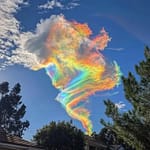Picture this: you look up and are suddenly captivated by a blazing, multicolored arc of light stretching across the sky. It’s not fire, but something even more extraordinary – a fire rainbow. This optical phenomenon looks like flames flickering among the clouds, a breathtaking spectacle that nature has crafted just for you.
What is a Fire Rainbow?
Despite its fiery name, a fire rainbow – or circumhorizontal arc, to give it its scientific title – has nothing to do with fire. It’s a rare, jaw-dropping atmospheric phenomenon that occurs under very specific conditions. This elusive beauty is an optical marvel, a once-in-a-lifetime sight for many.
The Science Behind the Magic
So, how does this stunning spectacle come to life? Here’s the secret:
- The sun needs to be at least 58 degrees above the horizon.
- Cirrus clouds, high in the sky, provide the perfect backdrop.
- Hexagonal ice crystals must be precisely aligned parallel to the ground.
When sunlight passes through these perfectly-positioned ice crystals, it bends and refracts, much like light through a prism, breaking into a stunning horizontal band of colors. The result? A striking rainbow-like display, with fiery red at the top and cool violet at the bottom – a visual feast that could stop you in your tracks.
Where and When to Spot a Fire Rainbow
Not every place on Earth is a prime spot for witnessing a fire rainbow. To increase your chances, you’ll want to head to regions that fall within 55 degrees north or south of the equator. You’re also more likely to catch this spectacle in areas with consistent sunshine and the right atmospheric conditions, like:
- Los Angeles, where fire rainbows are 5-10 times more common than in places like London
- The ideal window for viewing is March through September, when the sun’s angle is just right.
Fun Fact: Fire Rainbows Aren’t Actually Rainbows!
Here’s a fun twist: despite the name, fire rainbows aren’t “rainbows” at all. The term was coined by a journalist in 2006 because the appearance of these ethereal, wispy cirrus clouds reminds people of fire licking the sky. But in reality, fire rainbows don’t even need rain to exist – just sunlight and ice crystals in the right alignment.
The Rarity of Fire Rainbows
Seeing a fire rainbow is like stumbling upon a hidden treasure – it’s that rare. These dazzling displays are so infrequent that many people might never witness one in their lifetime. So, if you’re fortunate enough to spot one, take a moment to soak in the awe of the moment. And yes, go ahead – snap a picture to share your incredible luck with the world!
How to Boost Your Chances of Seeing One
Want to up your odds of witnessing this magical phenomenon? Here’s how:
- Look for cirrus clouds: Thin, wispy clouds high in the sky are your sign.
- Watch the sky when the sun is high: It needs to be at least 58 degrees above the horizon.
- Bring along a pair of polarizing sunglasses: These will help you see the vibrant colors more clearly.
- Stay patient and keep your eyes peeled: This is nature’s rarest show, after all.
A Scientific Wonder
At its core, a fire rainbow is an incredible display of nature’s light physics. The hexagonal ice crystals in the cirrus clouds act like natural prisms, bending and splitting sunlight into its full spectrum of colors. The result is a moment that seems too beautiful to be true – yet it’s a reminder of how truly magnificent the natural world can be.
See more at Science ABC
Nature is the ultimate artist, and fire rainbows are one of her most awe-inspiring masterpieces. So, keep your eyes on the sky – you never know when this dazzling phenomenon might grace your horizon!
Back to more weather education
Hi I am Marcus, MM0ZIF, a licenced Radio Amateur, Doctor of Musicology, amateur weather enthusiast. I over the years have been a Amateur Radio Tutor, Examiner, and a Regional Manager for the Radio Society of Great Britain.
This site is dedicated more towards Amateur Radio and Weather, with an angle on Technology too. I also maintain https://havenswell.com/ which is my other blog which is more aimed at cooking, hobbies and life in general as well as businness and networking.













